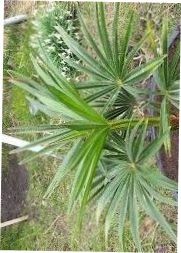Carandá
(Trithrinax brasiliensis)

Description
Trithrinax brasiliensis is a species of flowering plant in the family Arecaceae. It is known as carandá, burití or leque. It is considered a rare and endemic species in southern Brazil. It occurs in Argentina, southern Brazil, and eastern Bolivia, where it is popularly known to Spanish speakers as saó or saocito and to speakers of Chiquitano as baixhíxh. Nowadays it is considered a threatened species belonging to the category "In Danger" in the List of Threatened species of Rio Grande do Sul state, southern Brazil. Trithrinax is a genus of flowering plants in the subfamily Coryphoideae of the family Arecaceae. The name is derived from ancient Greek, where tri means three, and thrinax trident. It was named in 1837 by Carl Friedrich Philipp von Martius, a German botanist and explorer. Trithrinax species are spiny fan palms native to South America. They are resistant to cold, heat, wind, drought, poor soils and other adverse environmental conditions. Seeds germinate fast, but their overall growth rate is distinctly slow. Common features of Trithrinax species include: Flowers: Inflorescences, in the order of hundreds of units. Flowers with three sepals, three petals, six stamens and three carpels. Stem: Dead foliage is kept as a thick and spiny coat around the trunk. Leaves: Fan shaped (palmate), composed of strong resistant fibers. Shoots: Red coloured.
Taxonomic tree:







